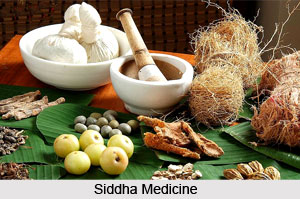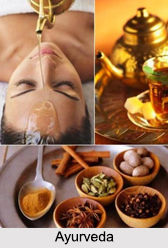 There are several types of treatment in Ayurveda. The procedure of treatment varies according to the patient"s mental and physical capability or strength. The kind of disease is the integral factor to choose the types of treatment in Ayurveda.
There are several types of treatment in Ayurveda. The procedure of treatment varies according to the patient"s mental and physical capability or strength. The kind of disease is the integral factor to choose the types of treatment in Ayurveda.
•Dwividh Chikitsa suggests 2 types of treatment in Ayurveda. In the first category of treatment, the patient has to undergo either "Sheet Upchaar" (cold treatment) or "Ushan Upchaar" (hot treatment).
•Triwidh Chikitsa suggests 3 types of treatment in Ayurvedic form of medicine. The first category of Triwidh Chikitsa includes the procedures of "Devvyaprashay Chikitsa", "Yuktivyaprashaya Chikitsa" and "Satvavajya Chikitsa". In the second category of Triwidh Chikitsa, forms of treatment are Antah-Parimarjan, Bahir-Parimarjan and Shastra-Parimarjan. The third category of Triwidh Chikitsa includes Langhan, Langhan Pachan and Doshavesechan (sanshodhan).
•Chaturwidh Chikitsa suggests 4 types of treatment in Ayurvedic medicine. The 4 paths of treatment in Chaturwidh Chikitsa include Sanshodhan Chikitsa, Snashma, Chikitsa, Ahar Chikitsa and Aachar Chikitsa.
•Panchwidh Chikitsa suggests 5 types of treatment in Ayurvedic medicine. The methods of treatment include, Vamana, Virechana , Nasya, Niruh Basti and Anuvasan Basti.
•Shadwidh Chikitsa suggests 6 types of treatment in the Ayurvedic practice. The six methods of Shadwidh Chikitsa are Langhan Chikitsa, Brihan Chikitsa, Rukshan Chikitsa, Snehan Chikitsa, Swedan Chikitsa and Stanbhan Chikitsa.
•Saptwidh Chikitsa refers to the 7 types of treatment in Indian Ayurveda. The methods of Saptwidh Chikitsa include Pachan, Deepan, Shudha (hunger), Trisha (thirsty), Vyayam (excercise), Dhupsewan and Vayusewan. 
•Daswidh Chikitsa refers to the 10 types of treatment in Indian Ayurveda. The ten methods of treatment within the sphere of Daswidh Chikitsa include Vaman, Virechan, Niruh vasti, Nasya, Pachan, Upwas, Pipasa, Vyayam, Dhupsewan and Vayusewan.
The types of treatment in Ayurveda are too vast to be discussed. However, the below-mentioned types of treatment in Ayurveda are the most practised ones in India.
Pizhichil is one of the types of treatment in Ayurveda that requires 2 weeks to be completed. This treatment is very effective in Rheumatic diseases like Arthritis, Paralysis, Paralysis-Agitanus, Hemiphlegia, Sexual Weakness, Nervous Weakness and Nervous disorders and so on.
Njavarakizhi is another type of treatment in Ayurveda of 14 days. It is a process by which the whole body or any specific part of the body is made to perspire by the application of certain medical puddings externally in the form of Boluses tied up in muslin bag. This treatment is for all types of rheumatism, pain in the joints, emaciation of limbs, high blood pressure, cholesterol and certain kinds of skin diseases.
Dhara is the process in Ayurveda, where some Herbal oils, medicated milk and medicated buttermilk are poured on the forehead in a special method for about 45 minutes in a day for a period of 7-21 days. This treatment is particularly for insomnia, vata predominated diseases, mental tension and certain skin diseases.
Basti is the method in Ayurvedic treatment that requires herbal oils and herbal extracts. They are applied through the rectum daily for a period 5 to 25 days. This treatment is for arthritis, paralysis, hemiplegia, numbness, gastric complaints associated with rheumatism and constant constipation. 
Sirovasthi is one of the types of treatment in Ayurveda, where certain lukewarm herbal oils are poured into a cap fitted on the head for 15 to 60 minutes per day according to the patient`s conditions for a period of one week. This treatment is highly effective for facial paralysis, dryness of nostrils, mouth and throat, severe headaches and other vata originated diseases.
Udvarthanam is a typical massage with herbal powder for about 30 to 45 minutes daily for 2 weeks, and cures Hemiphlegia, paralysis, obesity and certain rheumatic ailments.
Nasya method involves herbal juices and medicated oils. This treatment is highly effective for certain kinds of headaches, paralysis, mental disorders and skin diseases.
Snehapanam is one of the types of treatment in Ayurveda, where medicated ghee is given internally in an increased quantity for about 12 days to treat osteoarthritis, psoriasis and Leukaemia.
In Kizhi, herbal leaves and herbal powders are applied to the whole body in boluses with hot medicated oils for 45 minutes for 2 weeks. This process treats osteoarthritis, arthritis with swelling, spondylosis and sports injuries.
Dhanyamla Dhara is another effective type of treatment in Ayurveda for Hemiphlegia, paralysis and rheumatic complaints, where warm herbal liquid is poured all over the body in a rhythmic way through a special vessel for 45 minutes.
Yoni Prakshalanam is a purification process for genital organs and treats gynaecological disorders, where herbal oils and decoctions are applied through the vaginal route.
Kativasthi is a treatment where specially prepared warm medicated oil is kept over the lower back with herbal paste boundary; it cures any type of back pain and spinal disorders.
Urovasthi is a similar process that treats asthma and other respiratory problems, heart diseases and muscular chest pain.
Ksheeradhoomam is one of the popular types of treatment in Ayurveda, used for facial paralysis, speech disorders and other nervous disorders of the face.
Thalam is the process where special powder mixed with medicated oil is applied on the top of the head for 20 to 45 minutes. This treatment cures ENT problems, insomnia, migraine and others.
Lepanam process involves medicated herbal paste that is applied on the affected part to cure inflammatory conditions.




















